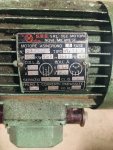jim gage
Member
- Location
- longmont Co. Boulder County
I am currently trying to find out if I should connect a motor in delta or wye.
The motor name plate states 400v 50 hz 48.5 amp and 480v 48.5 amp 60 hz
it is powered by a Berges inverter. This is a radial rock saw and they had lost 3 motors before I was called.
I would like to make sure I get this right to avoid another problem.
The motor name plate states 400v 50 hz 48.5 amp and 480v 48.5 amp 60 hz
it is powered by a Berges inverter. This is a radial rock saw and they had lost 3 motors before I was called.
I would like to make sure I get this right to avoid another problem.


